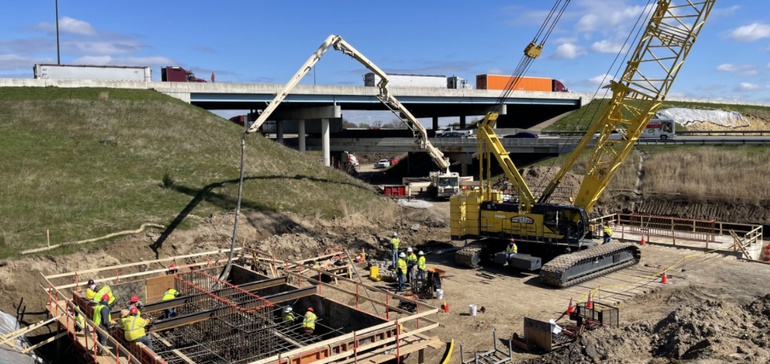Infrastructure work, especially for projects involving moving traffic, is dangerous. It’s crucial to recruit workers who are committed to safety.
The $1.2 trillion infrastructure bill working its way through Congress will bring massive amounts of investment to the rebuilding of crumbling highways and bridges, among other sectors.

Given the expected increase in construction projects related to road transportation, many construction workers will be working on jobs that involve moving traffic, and as such, their safety will be a top priority.
Here, Construction Dive talks with Casey Banks, senior regional risk control consultant at Travelers, about how to ensure safety for workers on infrastructure projects and how to recruit and retain safety-minded employees.
CONSTRUCTION DIVE: Why is it important to screen new workers?
CASEY BANKS: It is important to spend time recruiting workers that show a commitment to safety. Our claim data shows us that roughly 48% of construction injuries occur during a worker’s first year on the job, regardless of their industry experience. So, while it can be tempting to fill an empty role quickly, hiring a worker who prioritizes safety can play a part in preventing injuries.
To attract the right candidates, we recommend starting with a well-written job description detailing your organization’s safety requirements and the essential functions of the role, including any physical demands. Then, use a behavioral interviewing process, asking candidates how they performed in real-life settings, to get a better understanding of how they may perform on the job. This can help you identify those who share your organization’s core safety values.
Networking can also be a powerful tool. Ask others in your industry about who may be a good fit for your organization and review potential referrals from existing employees and other relationships. And remember, recruiting never stops. You can always be on the lookout for potential hires — that way you can build a robust pipeline of potential workers and be ready to act quickly when a position opens.
What about once a worker is hired? How can managers reinforce the importance of safety practices?
In addition to attracting and hiring qualified workers, be sure to have effective processes in place for onboarding, training and otherwise supporting your workforce.
After you’ve hired a worker or group of workers, you’ll want them to be fully aware of company values, your expectations and their responsibilities. This can be achieved with proper preplanning, onboarding and employee support. Since all jobsites have a unique set of risks, create a site-specific training with tailored safety practices to help familiarize workers with your safety culture.
Beyond a general safety overview, creating an orientation based on your workforce will help workers engage with and retain safety information. With a multigenerational workforce, mentorship programs can provide opportunities for less-experienced workers to gain the skills and knowledge to help them perform the job safely while ultimately building a stronger team environment on the job site.
Engaging employees is another great way to promote a safe and resilient workforce. Regular communications regarding safety, quality, schedule, ongoing feedback on both positive and at-risk behaviors and focusing on employees’ strengths are all good ways to build and maintain this engagement.
Finally, make sure safety doesn’t stop at the supervisory level. On-site managers are often the eyes and ears of the company, so their leadership can help encourage safe practices.
What steps do you recommend firms take to make sure subcontractors and other partners are on board?
The first step to mitigating risk when working with subcontractors and third parties is to know who you are hiring. This starts with a comprehensive pre-qualification and subcontractor selection process, which also gives the subcontractor an indication that your organization values safety and quality and is committed to working with contractors that share a similar dedication. Subcontractor evaluations may include interviews with senior leadership and reviews of OSHA citations, credentials and licenses, as well as jobsite safety inspections and safety process checks.
The next step is to have an effective risk transfer program in place to help mitigate risk. This goes beyond prequalification and focuses on contract administration. This process entails a review of all job files — including signed contracts, authorized contract language modifications or exceptions and subcontractor’s insurance requirements consistent with the contract — before a subcontractor steps foot on site.
Reviewing these documents will help ensure that the contract language is correct, and subcontractors have the right insurance in place with the appropriate coverage. It is important to maintain a consistent process across all subcontractors.
For these kinds of projects, workers are often very close to passing traffic. What can be done to help keep them safe?
A great place to start is to develop a written traffic control plan. This includes collaborating with state and local authorities from the start of the project to reduce the posted speed limit, monitor traffic speed and use speed-indicating message boards that tell motorists how fast they’re going.
Whenever possible, install positive protection such as concrete barrier walls, mobile barriers and crash attenuator trucks and trailers to provide physical separation. Internal traffic control plans that designate internal traffic flow, safe areas for workers, staging areas, worker walking paths and spaces to be avoided are also valuable.
Technology can be used to monitor traffic flow and activate additional advance warning message boards that alert drivers to upcoming conditions.
Lastly, use of intrusion warning alarms, high visibility personal protective equipment and area lighting at night as well as individual worker trainings and education on the benefits of facing traffic while working can all help reduce the potential for accidents.





